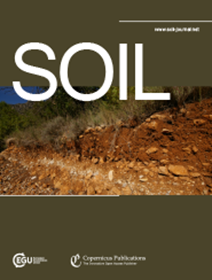Effects of moss restoration on surface runoff and initial soil erosion in a temperate vineyard
IF 4.3
2区 农林科学
Q1 SOIL SCIENCE
引用次数: 0
Abstract
Abstract. Soil erosion threatens soil fertility and food security worldwide, with agriculture being both a cause and a victim. Vineyards are particularly at risk due to the often steep slopes and detrimental management practices such as fallow interlines and bare soil under the vines. Therefore, the search for alternative management practices becomes vital, and vegetation covers, including mosses, have the potential to reduce soil erosion. However, research on moss restoration as an erosion control method is still in its infancy, and this form of erosion control has never been applied in vineyards. It is thus unclear whether moss restoration can be implemented in vineyards. In this study, the restoration of mosses was investigated by applying artificially cultivated moss mats in a temperate vineyard. The effects of moss restoration on surface runoff and sediment discharge were examined compared to bare soil and cover crops using rainfall simulation experiments (45 mm h−1 for 30 min) with small-scale runoff plots at three measurement times during 1 year (April, June, and October). Mosses initially showed considerable desiccation in summer, whereupon their growth declined. In October, the mosses recovered and re-established themselves in the vineyard, showing a high level of resistance. Moss restoration significantly reduced surface runoff by 71.4 % and sediment discharge by 75.8 % compared with bare soils. While moss restoration reduced surface runoff slightly more and sediment discharge slightly less compared with cover crops (68.1 % and 87.7 %, respectively), these differences were not statistically significant. Sediment discharge varied seasonally for moss restoration, especially from April to June; this is most likely due to the decline in moss cover and the foliage of the vines in June, as concentrated canopy drip points form on the leaves and woody surfaces of the vines, increasing erosion. Overall, moss restoration proved to be an appropriate and low-maintenance alternative for erosion control, as it requires no mowing or application of herbicides. However, future research should address challenges such as preventing moss mats from drying out in summer; developing methods for large-scale application; and evaluating whether mosses significantly impact soil water content, potentially reducing water availability for vines.温带葡萄园苔藓恢复对地表径流和初始土壤侵蚀的影响
摘要。土壤侵蚀威胁着全球的土壤肥力和粮食安全,农业既是原因,也是受害者。葡萄园的风险尤其大,因为往往是陡峭的山坡和有害的管理做法,如休耕的间道和葡萄藤下的光秃秃的土壤。因此,寻找其他管理办法变得至关重要,植被覆盖,包括苔藓,有可能减少土壤侵蚀。然而,将苔藓恢复作为一种侵蚀控制方法的研究还处于起步阶段,这种形式的侵蚀控制从未在葡萄园中应用过。因此,目前还不清楚是否可以在葡萄园中实施苔藓修复。本研究以温带葡萄园为研究对象,采用人工栽培苔藓垫的方法,研究了苔藓的恢复情况。通过降雨模拟实验(45 mm h−1,30 min),在1年(4月、6月和10月)的3个测量时间,与裸地和覆盖作物相比,研究了苔藓恢复对地表径流和沉积物排放的影响。苔藓最初在夏季表现出相当大的干燥,因此它们的生长下降。10月,苔藓在葡萄园中恢复并重新生长,表现出高度的抵抗力。与裸地相比,苔藓恢复显著减少地表径流量71.4%,沙流量75.8%。虽然与覆盖作物相比,苔藓恢复对地表径流的减少略多(分别为68.1%和87.7%),但这些差异在统计学上并不显著。苔藓恢复的输沙量随季节变化,特别是4 ~ 6月;这很可能是由于6月份藤蔓的苔藓覆盖和叶子减少,因为集中的树冠滴水点在藤蔓的叶子和木质表面形成,增加了侵蚀。总的来说,苔藓恢复被证明是一种适当的、低维护的侵蚀控制替代方案,因为它不需要割草或使用除草剂。然而,未来的研究应该解决一些挑战,比如防止苔藓垫在夏天变干;开发大规模应用的方法;并评估苔藓是否会显著影响土壤含水量,可能会减少葡萄树的水分可用性。
本文章由计算机程序翻译,如有差异,请以英文原文为准。
求助全文
约1分钟内获得全文
求助全文
来源期刊

Soil
Agricultural and Biological Sciences-Soil Science
CiteScore
10.80
自引率
2.90%
发文量
44
审稿时长
30 weeks
期刊介绍:
SOIL is an international scientific journal dedicated to the publication and discussion of high-quality research in the field of soil system sciences.
SOIL is at the interface between the atmosphere, lithosphere, hydrosphere, and biosphere. SOIL publishes scientific research that contributes to understanding the soil system and its interaction with humans and the entire Earth system. The scope of the journal includes all topics that fall within the study of soil science as a discipline, with an emphasis on studies that integrate soil science with other sciences (hydrology, agronomy, socio-economics, health sciences, atmospheric sciences, etc.).
 求助内容:
求助内容: 应助结果提醒方式:
应助结果提醒方式:


